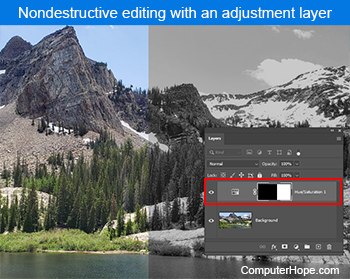Nondestructive editing

Nondestructive editing, unlike its counterpart, destructive editing, is any reversible change to an image. Many adjustment tools in programs like Photoshop allow you to make changes throughout the entire editing process. When pixels are added on a separate layer, for example, they do not affect the original image until it is flattened. If these changes are saved in a proprietary image format, like a PSD (Photoshop document), you can always access the layer information in Photoshop, allowing you to return and make changes.
In the pictured example, the image was desaturated using a Hue/Saturation layer, highlighted with a red rectangle. Since this is an adjustment layer on top of the original image, you can delete or hide it to reveal the full-color image underneath. We've done so using a layer mask to partially hide the layer.
Examples of nondestructive editing
- Using layer masks to hide portions of layers.
- Adding adjustment layers to alter hue, contrast, curves, and other color properties.
- Using a brush to add pixels on a separate layer above or below the original image.
- Adding text or other vector shapes on a separate layer.
Destructive editing, Image editor, Photoshop terms, Software terms
